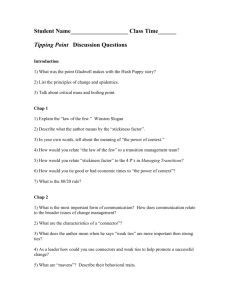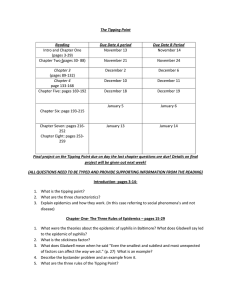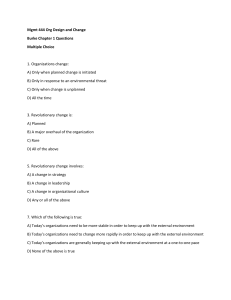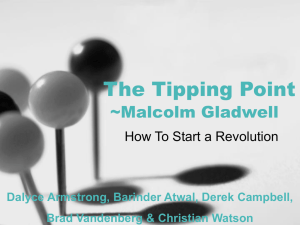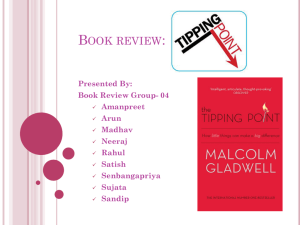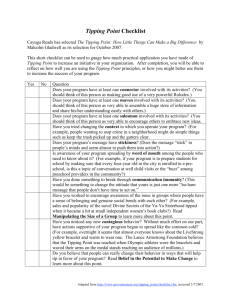Please respond to the following questions in a reflective journal
advertisement
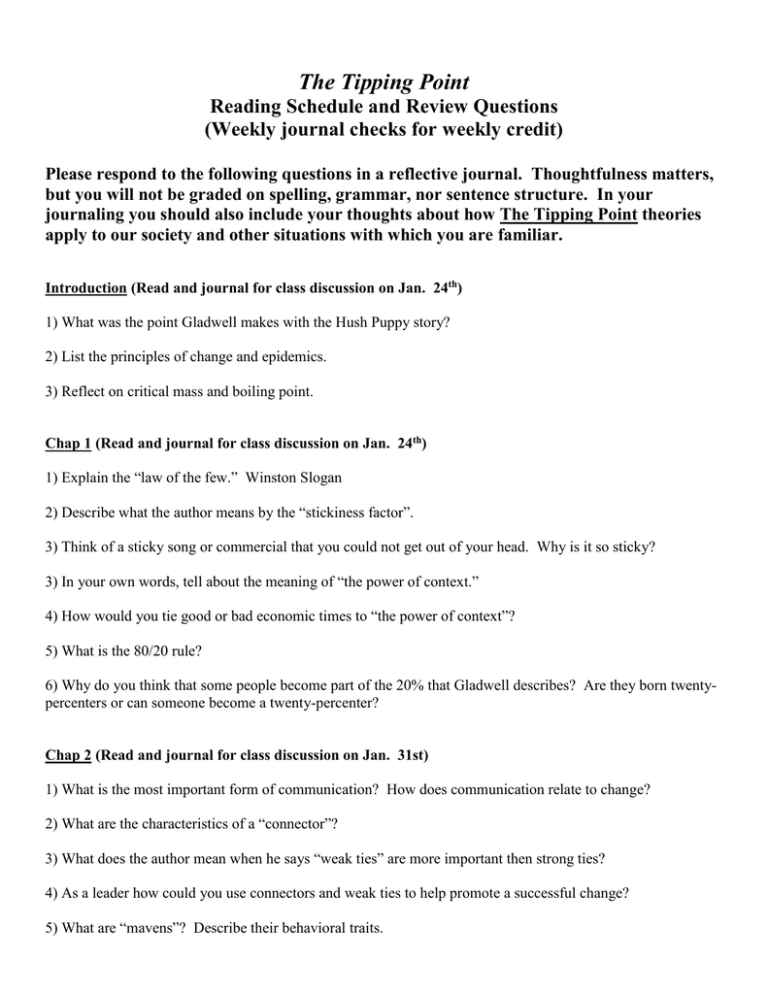
The Tipping Point Reading Schedule and Review Questions (Weekly journal checks for weekly credit) Please respond to the following questions in a reflective journal. Thoughtfulness matters, but you will not be graded on spelling, grammar, nor sentence structure. In your journaling you should also include your thoughts about how The Tipping Point theories apply to our society and other situations with which you are familiar. Introduction (Read and journal for class discussion on Jan. 24th) 1) What was the point Gladwell makes with the Hush Puppy story? 2) List the principles of change and epidemics. 3) Reflect on critical mass and boiling point. Chap 1 (Read and journal for class discussion on Jan. 24th) 1) Explain the “law of the few.” Winston Slogan 2) Describe what the author means by the “stickiness factor”. 3) Think of a sticky song or commercial that you could not get out of your head. Why is it so sticky? 3) In your own words, tell about the meaning of “the power of context.” 4) How would you tie good or bad economic times to “the power of context”? 5) What is the 80/20 rule? 6) Why do you think that some people become part of the 20% that Gladwell describes? Are they born twentypercenters or can someone become a twenty-percenter? Chap 2 (Read and journal for class discussion on Jan. 31st) 1) What is the most important form of communication? How does communication relate to change? 2) What are the characteristics of a “connector”? 3) What does the author mean when he says “weak ties” are more important then strong ties? 4) As a leader how could you use connectors and weak ties to help promote a successful change? 5) What are “mavens”? Describe their behavioral traits. 6) According to your author, what does a salesperson actually sell? 7) Think of some connectors, mavens, and salesmen you know and discuss why they fit into each category. Chap 3 (Read and journal for class discussion on Feb. 7th) 1) What does Gladwell mean by clutter? What does he mean when he says our society has a clutter problem? 2) What did the research conducted around Sesame Street and Blues Clues, say about the “stickiness factor”? 3) What is the story behind Levanthal’s Tetanus shot? 4) What is the James Earl Jones effect? Chap 4 (Read and journal for class discussion on Feb. 14th) 1) What does the “broken window theory” predict about people? Do you think that this theory risks excusing a criminal’s culpability? Why or why not? 2) What does Gladwell say about the relationship between a person’s character and their environment? Do you agree or disagree? Why? 3) How can an epidemic be reversed? 4) How does character interact with surroundings? Have you personally ever felt your feeling change because of your surroundings? Does this mean that if we can control our surroundings, we can control our character? Chap 5 (Read and journal for class discussion on Feb. 21st) 1) What is the Wells’ Ya-Ya Sisterhood? What implication does it have as related to change within a group? 2) What is the rule of 150? 3) What is the implication of the 150 rule to organizations and people in general? 4) Address the roles of groups, peer pressure, and social norms. How do these factors help when working to create change? 5) In your opinion are humans instinctively conformists who mimic the behavior they see around them? Why or why not? 6) Think of an organization or group that you consider highly successful. What factors make this group so effective? Chap 6 (Read and journal for class discussion on Feb. 21st) 1) Describe: Innovators Early adopters Early and late majority Laggards 2) Match the characters from Who Moved My Cheese to the above categories. 3) Who is Gordon Allport? 4) What are the 3 ways Allport states that rumors are distorted? 5) Knowing that humans “repackage and reformulate” information, what does Gladwell say about the role of Mavens, Connectors, and Salespeople? 6) Can you think of a product that had great potential but never really caught on? Chap 7 (Read and journal for class discussion on Feb. 28th) 1) In Gladwell’s discussion of teen smoking, he makes a distinction between contagious and stickiness that relates to almost all change efforts. What is the difference? (approx. p 234) Chap 8 (Read and journal for class discussion on Feb. 28th) What are the lessons you take away from the Tipping Point?
